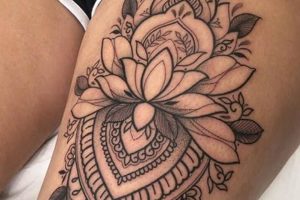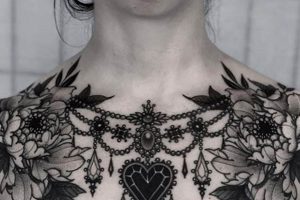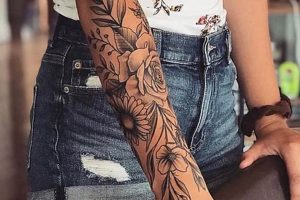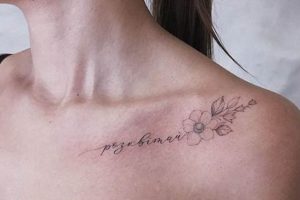Large-scale tattoo designs for women offer a canvas for intricate artwork, bold statements, and deeply personal narratives. These designs can incorporate diverse elements, from detailed portraits and sprawling landscapes to abstract patterns and symbolic imagery, allowing for significant artistic expression and visual impact. Examples include full or half-sleeve designs, back pieces, or tattoos that extend across multiple body areas.
Historically, extensive body art held cultural significance, often symbolizing status, spirituality, or group affiliation. Today, large tattoos continue to serve as powerful forms of self-expression, enabling individuals to showcase their passions, beliefs, and life experiences. The increasing acceptance and normalization of body art have further empowered women to embrace larger designs, pushing creative boundaries and challenging traditional aesthetic norms. The larger canvas allows for greater detail and complexity, transforming the body into a living work of art.
The following sections will explore various styles, placement considerations, and practical advice for those considering extensive tattoo projects. Topics will include popular motifs, the importance of artist selection, and pre- and post-tattoo care for optimal healing and long-term vibrancy. Additionally, the discussion will address common misconceptions surrounding large tattoos and offer guidance for making informed decisions about permanent body modifications.
Tips for Large-Scale Tattoo Designs
Careful planning is crucial for successful large-scale tattoo projects. Consideration of design elements, placement, and artist selection contributes to a visually compelling and personally meaningful result.
Tip 1: Research Tattoo Styles: Explore various artistic styles, such as realism, traditional, neo-traditional, Japanese, or watercolor, to determine which best suits the desired aesthetic and subject matter.
Tip 2: Choose a Reputable Artist: Seek artists specializing in large-scale work and possessing a strong portfolio demonstrating proficiency in the chosen style. Review testimonials and consult with potential artists to ensure compatibility.
Tip 3: Consider Placement Carefully: Body contours and movement affect the final appearance and longevity of a tattoo. Discuss optimal placement with the chosen artist to ensure the design complements the body’s natural lines.
Tip 4: Plan for Multiple Sessions: Large tattoos often require multiple sessions to complete. Discuss a realistic timeline and budget with the artist before commencing the project.
Tip 5: Prioritize Aftercare: Proper aftercare is essential for optimal healing and color retention. Follow the artist’s instructions diligently to minimize complications and maintain the tattoo’s vibrancy.
Tip 6: Reflect on the Design’s Longevity: Consider the long-term implications of the chosen design and its potential relevance over time. While tastes and preferences may evolve, a well-planned tattoo can remain a cherished piece of personal expression.
Tip 7: Don’t Rush the Process: Large-scale tattoos represent significant commitments. Thorough research, careful planning, and patience are essential for a successful and satisfying outcome.
By following these guidelines, individuals can approach large-scale tattoo projects with confidence, ensuring a result that reflects their personal vision and stands the test of time.
The subsequent section will delve further into specific design ideas, offering inspiration and guidance for crafting a unique and impactful piece of body art.
1. Placement
Placement is a critical factor in large-scale tattoo design for women, significantly influencing the aesthetic impact and overall composition. The body’s natural curves and contours serve as a dynamic canvas, and a well-chosen placement harmonizes the design with individual anatomy. For example, a sprawling floral design might flow gracefully along the spine, while a geometric pattern could accentuate the curves of the ribcage. Conversely, an ill-considered placement can disrupt the design’s visual flow and diminish its impact. A large portrait, for instance, might appear distorted if stretched across an unsuitable body part. Therefore, thoughtful placement enhances the interplay between the tattoo and the body, creating a cohesive and visually appealing result.
Beyond aesthetics, placement also affects the visibility and presentation of the tattoo. Individuals may choose highly visible locations like the forearm or back to showcase their artwork, while others may prefer more discreet placements, such as the thigh or ribcage, for personal expression reserved for select viewing. Practical considerations also influence placement choices. Certain professions may necessitate tattoos in less visible areas. Additionally, areas prone to stretching or friction, like the inner arm or stomach, may require specific design adaptations for long-term aesthetic integrity. Ultimately, placement serves as a crucial element in aligning the tattoo with individual preferences, lifestyle, and aesthetic goals.
Effective placement maximizes the impact of large-scale tattoos, transforming the body into a dynamic canvas. By considering anatomical contours, visibility preferences, and practical constraints, individuals can ensure the chosen placement complements the design, enhancing its visual appeal and personal significance. This understanding empowers informed decisions, resulting in a harmonious fusion of body and art.
2. Style
Style significantly influences the aesthetic impact of large-scale tattoo designs for women. A chosen style dictates visual language, influencing the design’s overall mood, message, and longevity. Selecting a style aligned with personal aesthetics and the intended narrative is crucial for a successful large-scale tattoo.
- Realism
Realism focuses on detailed and lifelike depictions, often featuring portraits, animals, or natural scenes. This style demands technical expertise from the artist and allows for intricate detail, creating visually striking and powerful tattoos. Examples include photorealistic portraits of loved ones or detailed depictions of animals. However, realism requires careful consideration of placement and skin tone for optimal results.
- Watercolor
Watercolor tattoos mimic the fluid and vibrant nature of watercolor paintings. This style utilizes soft color gradients and abstract shapes, often incorporating floral motifs or flowing designs. While visually appealing, watercolor tattoos may require more frequent touch-ups due to potential fading or blurring of colors over time. Successful watercolor tattoos depend heavily on the artist’s skill in replicating the delicate nature of the medium.
- Geometric
Geometric tattoos emphasize precise lines, shapes, and patterns, often drawing inspiration from sacred geometry or abstract designs. This style can range from minimalist linework to complex mandalas and offers versatility in terms of size and placement. Geometric tattoos generally age well due to their strong lines and defined shapes. They also offer opportunities for symbolic representation through specific geometric figures.
- Japanese Traditional
Japanese traditional, or Irezumi, is a rich and symbolic style characterized by bold lines, vibrant colors, and traditional imagery such as dragons, koi fish, and cherry blossoms. These tattoos often cover large areas of the body, telling stories and conveying symbolic meaning. Selecting a reputable artist specializing in this style is essential to ensure authentic representation and cultural sensitivity.
These styles, while distinct, can be combined or adapted to create unique and personalized designs. Careful consideration of style ensures the final tattoo aligns with individual preferences and desired aesthetics, ultimately contributing to a powerful and meaningful piece of body art.
3. Symbolism
Symbolism plays a pivotal role in large-scale tattoo designs for women, imbuing the artwork with personal meaning and narrative depth. Large canvases provide ample space for incorporating intricate symbolic elements, transforming the tattoo into a powerful visual representation of individual experiences, beliefs, and values. The choice of symbols adds layers of significance beyond mere aesthetics, creating a deeply personal and resonant piece of art.
- Cultural Heritage
Cultural heritage often serves as a significant source of symbolic inspiration. Women may choose to honor their ancestry through traditional patterns, mythological figures, or symbols representing their cultural background. For instance, Celtic knots, Native American totems, or Japanese kanji characters can convey a deep connection to one’s roots. These symbols not only celebrate cultural identity but also provide a visual link to ancestral history and traditions.
- Personal Experiences
Personal experiences, including milestones, challenges, or transformative moments, can be represented through symbolic imagery. A phoenix, for example, might symbolize overcoming adversity, while a compass could represent a journey of self-discovery. Incorporating elements from nature, such as specific flowers or animals holding personal meaning, can further personalize the narrative. These symbols serve as visual reminders of personal growth, resilience, and life’s significant chapters.
- Abstract Concepts
Abstract concepts like strength, love, freedom, or spirituality can be expressed through symbolic representation. Geometric patterns, mandalas, or abstract shapes can evoke these concepts, creating a visually compelling and thought-provoking design. For instance, a lotus flower often symbolizes purity and enlightenment, while a tree of life can represent growth and interconnectedness. These abstract symbols offer opportunities for introspection and personal interpretation, adding depth and complexity to the tattoo’s narrative.
- Nature and Spirituality
Elements from nature and spiritual traditions frequently find their way into symbolic tattoo designs. Animals, celestial bodies, botanical motifs, or spiritual symbols can represent a connection to the natural world or a specific belief system. For example, a wolf might symbolize loyalty and intuition, while a crescent moon could represent feminine energy and cycles. Incorporating these elements can imbue the tattoo with a sense of reverence, wonder, and connection to something larger than oneself.
The careful selection and integration of symbolic elements elevate large-scale tattoos from decorative art to powerful personal statements. These symbols deepen the meaning and resonance of the design, creating a lasting tribute to individual experiences, beliefs, and values. By weaving together personal narratives and symbolic language, large-scale tattoos become a profound expression of identity and a testament to the enduring power of art.
4. Artist Selection
Artist selection is paramount when realizing large-scale tattoo designs for women. The scale and complexity of these projects necessitate a skilled artist capable of translating intricate concepts into visually stunning and technically sound body art. A strong artistic partnership ensures the design’s successful execution and long-term aesthetic integrity. An artist’s specialization, experience, and portfolio should align with the desired style and subject matter. For instance, an artist specializing in photorealism might not be the ideal choice for a watercolor floral design. Similarly, an artist accustomed to smaller pieces might lack the experience and technical skill required for a large back piece. A mismatch between artistic style and project scope can compromise the final result, leading to aesthetic inconsistencies or technical flaws.
Beyond technical proficiency, effective communication and a collaborative approach are crucial elements of the artist selection process. Openly discussing design concepts, placement considerations, and potential challenges fosters a collaborative environment where artistic vision and client preferences converge seamlessly. A skilled artist not only executes the design but also provides valuable insights, suggesting modifications or enhancements that optimize the final result. This collaborative dynamic ensures the tattoo aligns with the individual’s vision while leveraging the artist’s expertise to achieve the highest artistic standards. A consultation prior to commencing the project allows for in-depth discussions about design elements, placement, and technical aspects, fostering a shared understanding and a strong artistic partnership.
Selecting the right artist significantly impacts the success of a large-scale tattoo project. Thorough research, portfolio reviews, and consultations are essential steps in identifying an artist whose technical skills, artistic style, and collaborative approach align with individual preferences and project requirements. This careful selection process fosters a strong artistic partnership, ensuring the final result is a technically sound, aesthetically compelling, and deeply meaningful piece of body art.
5. Pain Management
Pain management is an integral aspect of large-scale tattooing for women, particularly given the extended duration and intensity often associated with these projects. Effective pain management strategies enable individuals to endure longer sessions, contributing to the successful completion of intricate and extensive designs. Understanding and addressing pain concerns empowers women to approach these transformative experiences with greater confidence and comfort.
- Topical Anesthetics
Topical anesthetic creams and sprays, applied before and sometimes during the tattooing process, can numb the skin and reduce pain sensations. Lidocaine-based products are commonly used, offering temporary relief during the procedure. However, the effectiveness of topical anesthetics varies among individuals, and some may experience only partial pain reduction. Furthermore, some artists believe topical anesthetics can affect ink settling and skin texture, potentially influencing the final result. Therefore, discussing the use of topical anesthetics with the chosen artist is essential to ensure compatibility with their techniques and preferences.
- Nerve Blocks
While less common for standard tattooing, nerve blocks, administered by medical professionals, can offer more profound pain relief for specific areas. By targeting specific nerves, these injections can numb larger regions, potentially reducing discomfort during extensive sessions. However, nerve blocks require consultation and administration by a qualified medical practitioner, adding complexity and cost to the process. This approach might be considered for individuals with lower pain thresholds or for particularly sensitive areas of the body.
- Mindfulness and Relaxation Techniques
Mindfulness practices, such as deep breathing and meditation, can help manage pain perception during tattoo sessions. These techniques promote relaxation, reduce anxiety, and help individuals focus on the present moment rather than the discomfort. Practicing these techniques prior to and during the session can improve pain tolerance and create a more positive overall experience. Combining mindfulness with other pain management strategies can further enhance their effectiveness.
- Over-the-Counter Pain Relievers
Over-the-counter pain relievers, such as ibuprofen or acetaminophen, can be taken prior to the session to manage discomfort. However, it is crucial to avoid blood-thinning medications like aspirin, as they can increase bleeding and potentially affect the tattooing process. Consulting a physician regarding appropriate pain relief options is advisable, particularly for individuals with pre-existing medical conditions or those taking other medications.
Effective pain management contributes significantly to a positive and successful large-scale tattooing experience. By exploring and utilizing appropriate pain management strategies, women can approach these projects with greater confidence and comfort, ensuring a smoother process and a more enjoyable journey towards realizing their artistic vision.
6. Long-Term Care
Long-term care is essential for preserving the aesthetic integrity and vibrancy of large-scale tattoo designs for women. These intricate and extensive pieces represent significant investments of time, resources, and personal expression, necessitating diligent care to maintain their visual impact over time. Neglecting proper aftercare and long-term maintenance can lead to premature fading, blurring, and discoloration, compromising the design’s clarity and overall appeal. A large floral back piece, for example, meticulously crafted with vibrant colors and intricate details, can lose its brilliance if not protected from sun exposure and maintained with appropriate moisturizing regimens. Similarly, a sleeve tattoo depicting a personal narrative can lose its visual impact if the ink fades or the lines blur due to improper aftercare or neglect.
Consistent sun protection is crucial for preventing ink fading and maintaining color saturation. Regular application of high-SPF sunscreen to tattooed areas, especially during prolonged sun exposure, shields the ink from harmful UV rays that can cause discoloration and breakdown of pigments. Moreover, maintaining optimal skin health through regular moisturizing and proper hygiene contributes to the tattoo’s longevity and vibrancy. Hydrated and healthy skin provides a better canvas for the tattoo, allowing the colors to remain vivid and the lines sharp. Avoiding harsh chemicals, excessive scrubbing, and prolonged exposure to hot water further protects the tattoo from damage and preserves its artistic integrity. Touch-up sessions, performed by a skilled tattoo artist, can address minor fading or blurring over time, revitalizing the design and restoring its original vibrancy.
Diligent long-term care safeguards the artistic investment represented by large-scale tattoos. Consistent sun protection, moisturizing, and appropriate hygiene practices are essential for preserving color saturation, preventing premature fading, and maintaining the design’s overall visual impact. Understanding the long-term commitment associated with these extensive pieces empowers women to make informed decisions and adopt proactive care routines, ensuring their tattoos remain vibrant, expressive, and meaningful for years to come. This commitment to long-term care not only preserves the aesthetic quality of the tattoo but also demonstrates respect for the artistry and personal significance it embodies.
Frequently Asked Questions
This section addresses common inquiries regarding large-scale tattoo designs for women, providing factual information and practical guidance for those considering such projects.
Question 1: How does one determine the right placement for a large tattoo?
Optimal placement considers body contours, visibility preferences, and lifestyle factors. Consulting with an experienced tattoo artist is crucial for determining how a design interacts with individual anatomy and for ensuring the placement complements the body’s natural lines and movements.
Question 2: What factors influence the longevity of a large tattoo?
Longevity depends on several factors, including ink quality, aftercare practices, sun exposure, and individual skin characteristics. Diligent sun protection and consistent moisturizing are crucial for maintaining color vibrancy and preventing premature fading.
Question 3: How does one choose the right tattoo artist for a large-scale project?
Selecting an artist specializing in large-scale work and possessing a strong portfolio demonstrating proficiency in the desired style is essential. Consultations allow for discussing design concepts, placement considerations, and technical aspects, ensuring compatibility and a collaborative approach.
Question 4: What are the typical costs associated with large tattoo designs?
Costs vary based on factors such as design complexity, size, artist experience, and geographic location. Large-scale projects often require multiple sessions, and it’s essential to discuss a realistic budget with the artist before commencing the project.
Question 5: What are effective pain management strategies for large tattoo sessions?
Effective strategies include topical anesthetics, mindfulness techniques, and over-the-counter pain relievers (avoiding blood thinners). Consulting a physician regarding appropriate pain relief options is advisable, especially for individuals with pre-existing medical conditions.
Question 6: Can large tattoos be removed or covered up if desired?
Laser removal can lighten or remove tattoos, but complete removal is often challenging, especially with large, complex designs. Cover-up tattoos are also an option, but they require careful planning and a skilled artist to effectively conceal the existing design. Both options involve additional costs and considerations.
Careful planning, artist selection, and diligent aftercare contribute significantly to the success and longevity of large-scale tattoo projects. Addressing these factors ensures a positive experience and a lasting piece of personal expression.
This concludes the frequently asked questions section. The following section will offer a concluding summary and final thoughts on embarking on large-scale tattoo projects.
Conclusion
Large-scale tattoo designs for women represent a powerful medium for self-expression, enabling individuals to transform their bodies into living canvases that reflect personal narratives, beliefs, and aesthetic visions. Careful consideration of placement, style, and symbolism ensures the design harmonizes with individual anatomy and conveys intended meanings. Selecting a skilled and experienced artist specializing in large-scale work is paramount for achieving technical precision and artistic excellence. Furthermore, addressing practical aspects such as pain management and long-term care preserves the integrity and vibrancy of these intricate artworks, ensuring they remain impactful and meaningful for years to come. Understanding these elements empowers informed decisions and contributes to a positive and fulfilling tattooing experience.
Large-scale tattoos represent significant commitments, both artistically and personally. The journey requires thorough planning, thoughtful consideration, and a willingness to embrace the transformative power of body art. By approaching these projects with informed awareness and a deep understanding of the process, individuals can embark on a rewarding journey of self-expression, creating lasting and meaningful artwork that reflects their unique identities and aesthetic visions. Ultimately, large-scale tattoos offer a powerful means of embodying personal narratives, transforming the skin into a canvas that tells a story and celebrates the enduring connection between art and the human experience.







